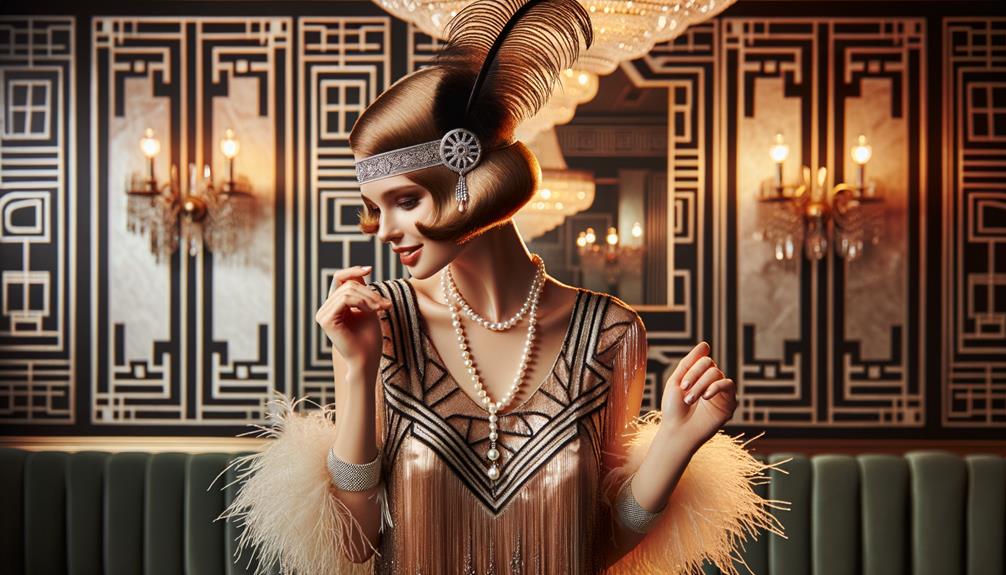After the war, teenage fashion took the world by storm. The youth population grew from 3 million to 4 million by 1966, influenced by the 1944 Education Act and economic shifts. Teenagers were earning more, making around $11.25 a week by 1956, and spending it on music, movies, and cars. Rock and roll icons like Elvis Presley and James Dean became symbols of teenage rebellion. Greasers in leather jackets, Ivy Leaguers in preppy attire, and girls in poodle skirts – this era's youth culture left a lasting impact on fashion and media. There's much more to uncover about this distinctive period.
Historical Context
In the years following World War II, significant changes were underway. The baby boom and education reforms reshaped society, leading to the rise of a distinct youth culture. By 1966, the number of young people in the population had grown from 3 million to 4 million. This surge created a new social category.
The 1944 Education Act played a pivotal role in this transformation. It expanded secondary education, raising the school-leaving age to 15 by 1947. This policy institutionalized youth as a separate group.
The introduction of National Service, active from 1948 to 1963, further defined this demographic. It addressed specific youth issues and requirements, solidifying their unique cultural identity. Economic shifts demanded flexible, cheaper youth labor, leading to increased earnings and discretionary spending for young people.
Media and youth services began to target this growing group, recognizing their distinct culture. This deliberate focus helped solidify youth culture as a powerful social force. By the 1950s and 60s, young people were seen not just as a demographic but as a culture with its own values and aesthetics.
Observing this era, it's clear how educational policies and economic factors intertwined, creating the conditions for the growth of a unique and influential youth culture.
Economic Boom and Teen Spending
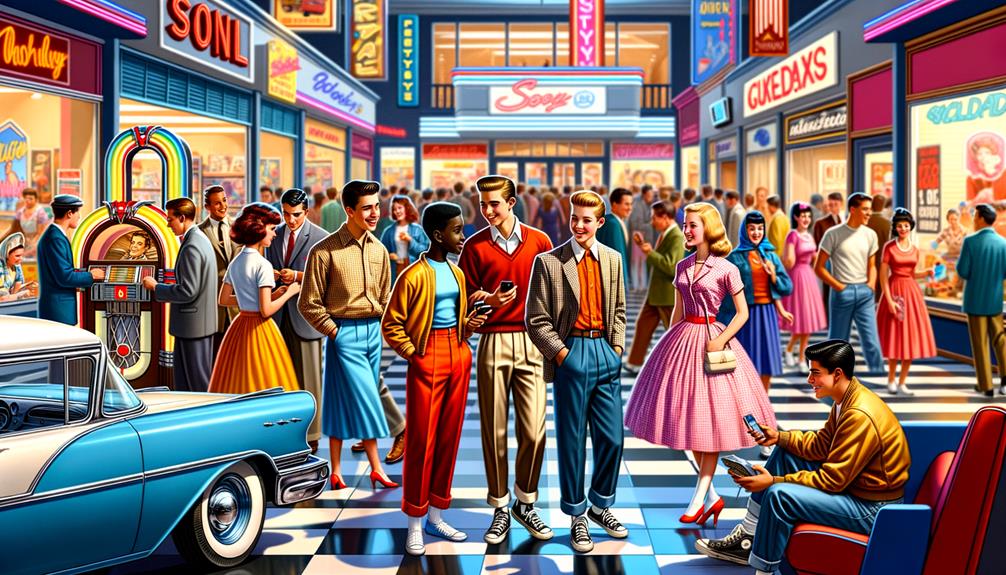
The 1950s and 60s saw a surge in teenage spending power, thanks to the economic boom that followed World War II. With incomes rising from an average of $6.90 per week in 1946 to $11.25 in 1956, young people had more money to spend on their own interests.
Businesses quickly recognized the potential of this new consumer group. Advertisements and marketing campaigns were tailored to appeal to teenage spenders. Music, movies, and cars became the focus, as teenagers funneled their earnings into these areas, shaping a new market landscape.
This economic shift allowed young people to establish their own distinct culture. Fashion, music, and social activities began catering specifically to teenagers, who now had the means to define their own identity. In contrast to today's tech-savvy youth, 1950s teens concentrated their spending on tangible goods and entertainment.
The economic boom of the mid-20th century didn't just change bank accounts; it redefined generations. Young people, armed with newfound spending power, became the architects of their cultural identity.
Influence of Rock and Roll
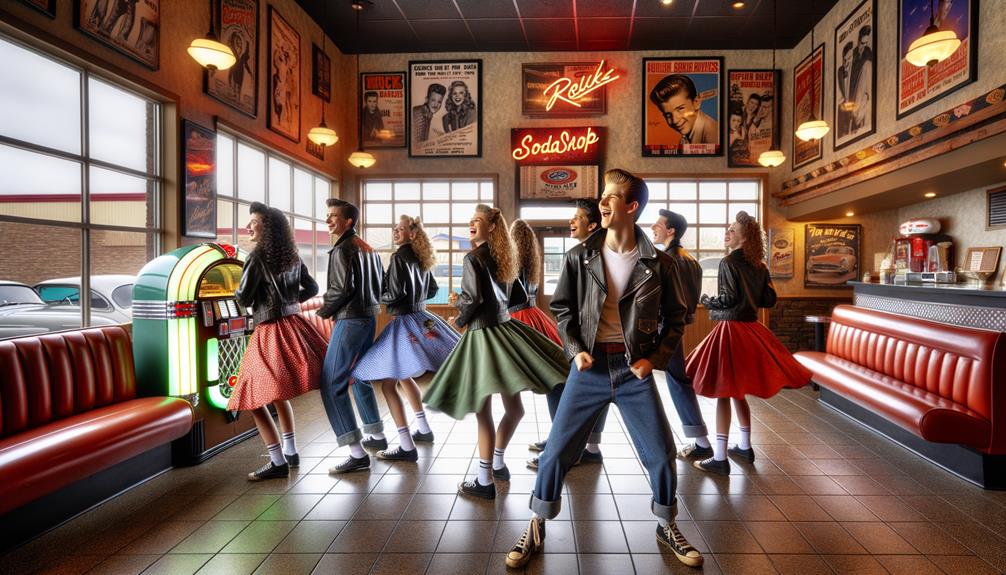
Rock and roll's rise in the '50s wasn't just about the music – it shaped how teenagers dressed and acted too. Icons like Elvis and Chuck Berry influenced looks that screamed rebellion and individuality. This era kicked off youth-driven style trends that defined a generation.
Music Icons' Fashion Impact
Leather jackets and blue jeans became symbols of rebellion, inspired by icons like James Dean and Elvis Presley. These fashion choices weren't just clothing; they were statements. The music that blared through the streets defined a new era for the young. James Dean's brooding looks and Elvis's energetic performances set the stage for a cultural shift.
Teen idols like Marlon Brando embodied this working-class aesthetic. Their influence was undeniable. It wasn't just about appearance; it was an attitude. The greased-back hairstyles and casual jeans broke away from the formal norms of earlier decades. It was raw, unrefined.
The music industry saw an opportunity. They aggressively marketed these styles, understanding the power of youth culture. Rock and roll wasn't just music; it was a movement. The style of these performers, blending elements of working-class and African American culture, legitimized previously taboo fashion choices among white teenagers.
This shift seeped into every aspect of life. Hairstyles, makeup, even toys like the Barbie doll, reflected this new teenage ideal. The doll itself was marketed as a 'Teen-age Fashion Model'. It was more than fashion; it was a revolution in how youth saw themselves.
Rebellion and Individuality
Embracing rock and roll felt like a defiant act. It was more than just music; it embodied a spirit of rebellion and individuality. Figures like Elvis Presley with his captivating dance moves and James Dean with his brooding look became icons for teenagers looking to break free from societal norms. Greased hair, leather jackets, and blue jeans became staples, challenging the polished expectations of previous generations.
Rock and roll dance parties and drive-in movies were the battlegrounds where teenagers asserted their independence. We rejected parental expectations, choosing raw energy and freedom over conformity. The tension was palpable as adults feared the corrupting influence of this new genre. They tried to censor it, sparking moral panics about juvenile delinquency. But the more they resisted, the stronger our resolve grew.
By the 1960s, rock and roll festivals and concerts had become the epicenters of teenage counterculture. The genre's association with rebellion solidified, and it provided a soundtrack for our quest for individuality. Our style was our statement, and our music was our manifesto.
| Rock Icons | Rebellious Aesthetic | Teenage Activities |
|---|---|---|
| Elvis Presley | Greased Hair | Dance Parties |
| James Dean | Leather Jackets | Drive-in Movies |
| Rock Festivals | Blue Jeans | Concerts |
Rock and roll gave us a voice to express ourselves.
Youth-Driven Style Trends
With the rise of rock and roll, our fashion mirrored its raw, rebellious energy. We donned blue jeans and white t-shirts, echoing the simplicity of icons like Elvis Presley and James Dean. Leather jackets became a tangible layer of defiance against the world.
Dance crazes like the jitterbug and the twist demanded freedom of movement, so our clothes adapted – less restrictive, more expressive. Teen culture, driven by the pulse of rock and roll, embraced styles that allowed us to move, to live, to defy.
Hairstyles transformed too. Greased-back quiffs and towering beehives marked us out, signaling our connection to a counterculture that valued individuality. The music industry took notice, targeting us with rock and roll artists and youth-focused media. We became the focus, our sartorial choices shaping the market.
Our fashion was more than just fabric – it was identity, rebellion, and a statement of belonging to a culture that was ours. We didn't just follow trends; we defined them. The influence of rock and roll was profound, creating a unique blend of style and attitude that redefined what it meant to be young.
Iconic Male Fashion
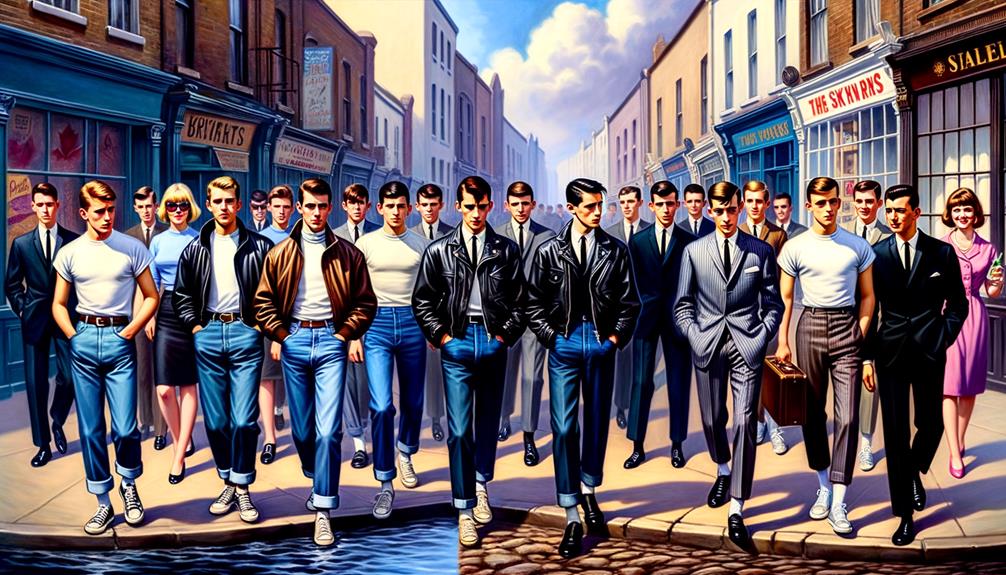
The fashion of the 1950s and 60s blended rebellion and refinement. Greasers with their slicked-back hair and leather jackets stood in contrast to the clean-cut Ivy League style. Meanwhile, rock 'n' roll introduced tight pants and bold patterns, leaving a lasting impression.
Greaser Style Emergence
The greaser style emerged from the rebellious spirit of the 1950s. This look showcased slicked-back hair, leather jackets, and blue jeans as symbols of teenage defiance. It arose in the aftermath of World War II, reflecting the shifting attitudes of the era. Unlike the British Teddy Boys and their Edwardian suits, American greasers embraced a working-class aesthetic that was a bit rough around the edges.
The key elements of the greaser style included:
- Slicked-back hair, achieved with pomade, which signified nonconformity.
- Leather jackets, worn as a form of armor to convey toughness.
- Blue jeans, a staple that represented rebellion against conventional norms.
Figures like James Dean and Marlon Brando helped immortalize this style, turning it into a cultural phenomenon. It wasn't just about the clothes; it was an entire identity. Rock and roll provided the soundtrack to the greasers' lives, amplifying their rebellious undertone.
Greasers would roam the streets, engage in drag racing, and frequent diners. This lifestyle was as much a part of the look as the fashion itself. The greaser style wasn't just a passing fad; it laid the groundwork for future subcultures and continues to influence fashion today.
Ivy League Influence
Among the iconic styles of the 1950s and 60s, Ivy League fashion stood out with its crisp button-down shirts, khaki pants, and loafers, embodying a clean-cut, preppy aesthetic. This style emerged from the elite East Coast universities, where tradition met a new post-Second World War sensibility.
The popularity of this fashion seems to have been driven by brands like Brooks Brothers, J.Press, and Bass, which catered to an emerging market of affluent teenagers. These teens, benefiting from postwar prosperity, sought to express their newfound independence and status through their attire. The look was sleek, understated, and sophisticated, a stark contrast to the rebellious garb of other youth subcultures.
Figures like President John F. Kennedy and Paul Newman exemplified this style, reinforcing its association with youthful success and refinement. The Ivy League look wasn't just about clothes; it symbolized aspiration and the American dream, resonating deeply with the upper-middle-class teenagers of the time.
The rise of Ivy League fashion highlights a moment when the clean-cut preppy aesthetic became a way for young people to express their social and economic aspirations, marking a distinct chapter in the story of youth culture.
Rock 'n' Roll Fashion
While Ivy League fashion was all about polished preppy style, the rock 'n' roll look of the 1950s embodied rebellion and defiance. Young men broke free from traditional norms, embracing a casual aesthetic that became iconic. The white tee, blue jeans, and black leather jacket, popularized by stars like James Dean and Elvis Presley, became a shorthand for youthful nonconformity.
Greased-back quiffs were a staple for working-class youth, emulating musical idols like Bill Haley and Jerry Lee Lewis. This look spoke volumes without saying a word.
The rocker aesthetic diversified into subgenres, each with its own distinct style. Rockabilly fans sported western-inspired wear, while surf rock enthusiasts donned board shorts and Hawaiian prints. Teddy boys rocked black leather jackets, skinny jeans, and engineer boots.
The baggy 'zoot suit,' with its high-waisted, wide-legged pants and long, boxy jacket, was embraced by African American and Hispanic youth as a symbol of defiance against mainstream culture. Through these fashion choices, young men of the 1950s redefined what it meant to be young and free.
Iconic Female Fashion
How did teenage girls in the 1950s and 60s express their budding sense of style? The answer lies in iconic fashion pieces and influential figures.
The 1950s saw the rise of the poodle skirt, a simple yet expressive piece that symbolized teenage rebellion. Marilyn Monroe's hourglass figure set the standard, with her figure-hugging dresses and sweaters becoming templates for young women seeking to emulate her allure.
The early 1960s brought a shift, with the mod look emerging. Mary Quant's mini skirt redefined youth fashion, as geometric, bold clothing spoke to a generation hungry for change. Meanwhile, Jackie Kennedy's elegant style left a mark, inspiring young women to seek a more refined, polished appearance.
Impact on Modern Culture
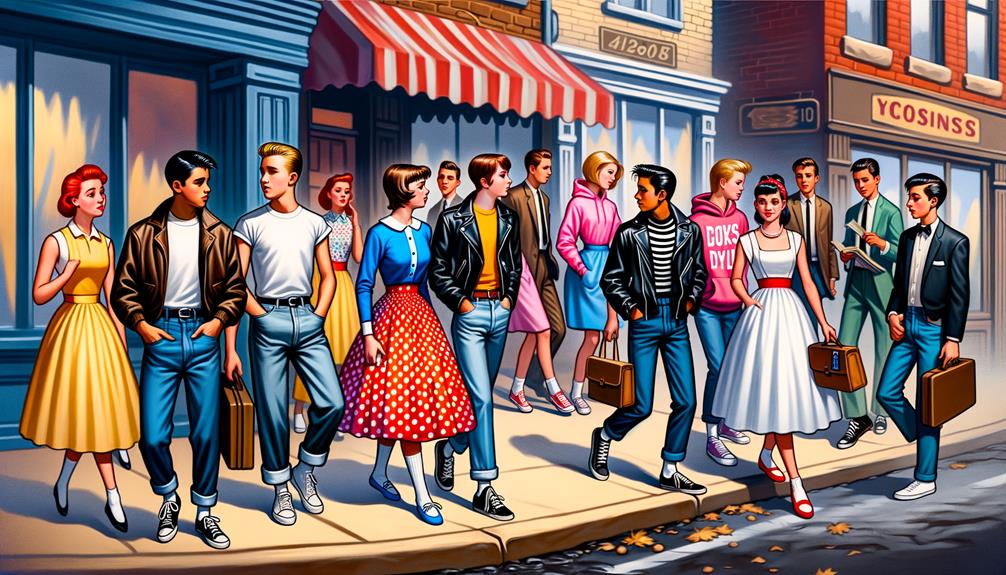
The teenage fashion revolution of the 1950s and 1960s laid the groundwork for today's youth culture's lasting influence on mainstream style and media. This era marked the emergence of a distinct demographic with its own fashions, transforming how society views and markets to young people.
We can still see the echoes of 1950s and 1960s teenage fashion in current trends. Iconic items like jeans, t-shirts, and leather jackets transcend generations, becoming more than just clothes – they represent rebellion and individuality. The spending power teens gained back then continues to drive today's fashion industry and media.
We can see youth culture's impact on modern society in three key areas:
- Fashion Evolution: Trends from the post-war era provided a blueprint for later subcultures like punk, hip-hop, and streetwear.
- Media Influence: Teen magazines and music television from the past set the stage for today's youth-targeted media.
- Social Activism: The generational tensions of the 1950s and 1960s foreshadowed the activism seen in later movements.
Today, youth culture's distinctive style continues to shape mainstream fashion and media, proving the lasting legacy of the teenage fashion revolution.
Frequently Asked Questions
How Did Teen Culture Emerge in the 1950s?
After the Second World War, teens had more money and free time than ever before. Businesses recognized this as an opportunity and started marketing products specifically to young people. Rock and roll music emerged as a key part of teen culture, helping to define their identity. While some parents were worried about this new youth culture, the media played a big role in solidifying teens as a distinct social group. This was a significant societal shift in the 1950s.
What Influenced Fashion in the 1950s?
Fashion in the 1950s reflected a mix of rebellion and conformity. Icons like Elvis pushed boundaries with their denim and leather looks. High schools favored practical, no-frills styles. Peer groups and new fabrics shaped the evolving youth fashion scene.
What Led to the Creation of Youth Culture in the Postwar 1950S Period?
After World War II, several factors contributed to the emergence of a distinct youth culture in the 1950s. The expansion of secondary education allowed more young people to access higher learning. At the same time, increased discretionary income and the post-war baby boom created a large population of teenagers with more spending power and free time. This demographic shift allowed youth-oriented media, such as rock and roll music, to gain traction and solidify young people as a unique social group with their own cultural identity.
What Are Three Examples of Youth Culture in America in the 1950s?
Three key elements of 1950s youth culture in America were rock and roll music, drive-in theaters, and teenage magazines. These reflected the emerging identity and self-expression of a new generation as society underwent significant changes.
Rock and roll exploded in popularity, giving teens a vibrant musical outlet that defied traditional norms. Drive-in theaters offered a space for young people to socialize and enjoy the latest films away from parental supervision. Meanwhile, magazines tailored specifically to teenage readers explored their interests, fashions, and evolving independence.
These cultural touchstones allowed 1950s youth to carve out their own space, explore rebellious tendencies, and solidify a distinct identity separate from their parents' generation. They became hallmarks of a youth culture that was rapidly shaping America's social landscape.
Conclusion
Looking back, teen fashion in the '50s and '60s was about more than just clothes. It was a way for young people to rebel, express their identity, and feel free. Some may see it as superficial, but those styles laid the groundwork for modern youth culture. Rock and roll, economic shifts, and iconic looks shaped who we are today. Fashion became a voice for the younger generation. Now, every ripped jean and leather jacket echoes the spirit of that era. We can't ignore its lasting impact.



